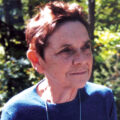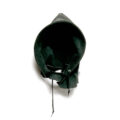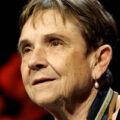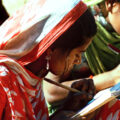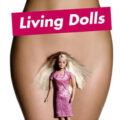Best American: Adrienne Rich’s Radical Canonization

Best American Poetry 1996
edited by Adrienne Rich
When my first undergraduate poetry professor taught “Aunt Jennifer’s Tigers” and “Diving into the Wreck” side by side, to demonstrate how Rich’s work was transformed by feminism, I marveled how her tidy stitches became oceans. I was entranced by the nerviness of “Diving into the Wreck,” so fraught with mythos, seeking, and possibility; it read like a spell. Like the speaker in the poem, I was searching for a lineage, and Rich became a foremother.
Feminism was my dark art in college. Another was the world of writing. I read everything Rich wrote and everyone she wrote about and began to write myself, and alongside Gloria Anzaldua, bell hooks, Lorna Dee Cervantes, Cheri Moraga, and dozens of other feminists, she occupied my feminist pantheon. Rich’s work taught me how to construct a rigorous feminist subjectivity, and those lessons are imprinted on the poems I write today. Besides integrating the personal into a larger political context, I began to see all lyric occasions as being implicitly feminist.
The legacy of her aesthetics and politics is staggering, and, most importantly, wide-reaching. So many of us write poems for the “book of myths in which our names do not appear,” the book she claimed for us. I felt that I knew her and was carrying on my version of her battle. Nearly thirty years of relentless anti-equality dogma has made feminism a slur, but I stuck it out, stick it out to this day.
Revisiting Rich’s work when writing my last book reminded me of how rigorous she was in her thinking about women’s equality and also women’s power. She taught me homosociality and about the ambivalence of motherhood and about a truly utopian world for women. Still, in my mind, one of the best things Rich ever did was edit the Best American Poetry 1996.
The series, which since the late eighties had introduced me to a range of poets, had also been reinforcing a very specific profile of poetry at that point, one that often excluded writers on the margins. I remember the uproar, tittering, and dismissal of the book when it first came out, but I also recall feeling affirmed that the exclusion I had come to see as a norm wasn’t a figment of my imagination. She uses the platform and occasion to call out American literary journals and publishing ventures for their racial homogeneity. In this way, the introduction stops being a preface and starts to act like a call to arms.
Rich names this exclusion and its historical and economic bases in her preamble, with epigraphs by John Berger, Walt Whitman, and Charles Bernstein (whose words would best represent the edition’s vision: “As long as social relations are skewed, who speaks in poetry will never be a neutral matter”). Addressing the book’s reader directly—“Whoever you are that picks up this anthology”—Rich begins by quickly dispensing with superiority as a lens for selecting poems. To her, the book’s purpose is to reflect the myriad bodies and lives in all existence and to give them sustaining music:
As I read throughout the year I found myself asking, “What does it mean for poets when so powerful an idea, prescription, vision of the future—however unrealized—is so abruptly abandoned or driven underground?” Increasingly it seemed to me that it’s not any single poem, or kind of poem, but the coming together of many poems, that can reassemble what has been scattered, can defy the space that separates, can offer, in Muriel Rukeyser’s words, the truths of outrage and the truths of possibility (The Life of Poetry).
This isn’t Rich’s first rodeo, and she had never backed down from her explicitly feminist agenda. On Lies, Secrets, and Silence, which refracts motherhood, language, and race through an ardent feminist lens, had been published already. In 1986, she had written a poem, “Negotiations,” which foreshadowed this later editorial work:
Someday if someday ever comes we’ll go
back and reread those poems and manifestos
that so enraged us in each other’s hand
I’ll say, But damn, you wrote it so I
couldn’t write it off You’ll say
I read you always, even when I hated you
A wide reader, her critique in the Best American is not directed at any particular aesthetic. Instead, she exposes the ways in which many American aesthetics, commonly reflected in mass-market anthologies of this kind, fail the political body:
We need poetry as living language, the core of every language, something that is still spoken, aloud or in the mind, muttered in secret, subversive, reaching around corners, crumpled into a pocket, performed to a community, read aloud to the dying, recited by heart, scratched or sprayed on a wall. That kind of language.
I think it’s this expansive view of poetry’s causes and effects that guided her editorial approach to her volume of BAP. To be in crisis and not respond would be a moral failure. Two of the edition’s most vocal critics were Harold Bloom, who excluded the volume in his anthology The Best of the Best, and Marjorie Perloff, who writes:
Too many of the relentlessly PC poems in this volume are maudlin, self-righteous, boring, and ultimately just plain incompetent; I would add that Rich’s rant against contemporary culture in her own Introduction seems as unaware of the basic facts of economic life in late twentieth-century America as it refuses to acknowledge the genuinely radical poetry now being written.
Perloff’s critique mirrors an observation that Rich herself makes: “I was constantly struck by how many poems published in magazines today are personal to the point of suffocation. The columnar, anecdotal, domestic poem, often with a three-stress line, can be narrow in more than a formal sense.” The subtext of Perloff’s critique is that multicultural (employed as a slur) inclusion itself is relentlessly PC.
The edition includes Sherman Alexie, Wanda Coleman, Martin Espada, Marilyn Chin, C.S. Giscombe, Yusef Komunyakaa, Valerie Martinez, Pat Mora, Wang Ping, Alberto Rios, Reginald Shephard, Roberto Tejada and many other poets of color alongside W.S. Merwin, Alice Notley, Jane Miller, Karen Volkman, and Jean Valentine, writers who reflect different dominant aesthetics. The book’s prescience is actually quite stunning. The array of poets and the poems selected assume that the reader will be interested in heady considerations of American identity, a gesture initiated by Walt Whitman. That we’re still talking about this edition and no other speaks to how actively Rich transgressed an invisible supremacy.
In a talk that she gave at the University of Stirling in 2006,“Poetry and the Forgotten Future,” Rich describes her vision of poetry’s utility and citizenship. The talk reveals her vast familiarity with poets of dissent from all over the world and how poetry has been deployed as resistance and political action. To Rich, more needs to be done:
For now, poetry has the capacity—in its own ways and by its own means—to remind us of something we are forbidden to see. A forgotten future: a still-uncreated site whose moral architecture is founded not on ownership and dispossession, the subjection of women, torture and bribes, outcast and tribe, but on the continuous redefining of freedom—that word now held under house arrest by the rhetoric of the “free” market.
Rich’s optimism in poetry is the faith that buoys me when I consider how utterly futile poetry feels to me, as a reader and also a poet writing poems meant to transmit, communicate, and touch. She doesn’t shy away from a critique of formally innovative poetry, which might be how she earns Perloff’s ire, but she doesn’t exclude these more formally inventive poets either. The olio quality of the anthology reads as richly and bizarrely as any true sampling of American poetry might be.
About Carmen Giménez Smith
Carmen Giménez Smith is the editor-in-chief of Puerto del Sol and publisher of Noemi Press. She teaches at New Mexico State University in Las Cruces, New Mexico. Her most recent book, Milk and Filth, was a finalist for the National Book Critics Circle Award.

